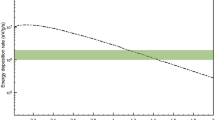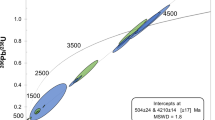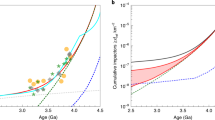Abstract
Theories of supernova explosion (SNEs)1–3 as well as correlation of NO−3 in Antarctic ice cores with the dates of historical supernovae4, suggest that many Type I SNE may yield an intense 1050 erg emission of γ rays. Such a SNE may be expected to occur within a few tens of light years of our Solar System once every hundred million years or so5,6. A short γ-ray pulse of this magnitude would not only directly affect the terrestrial atmosphere in ways that can be important for surface life5, but also be absorbed by the lunar surface. Depending on the γ-ray energies involved, the upper centimetre of lunar surface soil can be evaporated by heating or ejected by the emergence at the surface of a rising pressure pulse. Such expelled lunar soil, moving at speeds near the 2 × 105 cm s−1 lunar escape velocity, could be captured by the Earth's gravitational field and gradually settle through the atmosphere to the Earth's surface. Geological strata for that epoch might then be expected to show an overabundance of iridium (but probably less than that found by Alvarez et al.7 in 65-Myr-old sedimentary layers at Gubbio). This would occur since the expelled lunar surface soil should be characterised by an Ir abundance greatly enriched, relative to terrestrial of lunar rocks, by micrometeorite bombardment.
This is a preview of subscription content, access via your institution
Access options
Subscribe to this journal
Receive 51 print issues and online access
$199.00 per year
only $3.90 per issue
Buy this article
- Purchase on Springer Link
- Instant access to full article PDF
Prices may be subject to local taxes which are calculated during checkout
Similar content being viewed by others
References
Colgate, S. A. Can. J. Phys. 46, S476 (1968).
Terry, K. D. & Tucker, W. H. Science 159, 421 (1968).
Colgate, S. A. Ann. N. Y. Acad. Sci. 262, 34 (1975).
Rood, R. T., Sarazin, C. L., Zeller, E. J. & Parker, B. C. Nature 282, 701 (1979).
Ruderman, M. Science 184, 1079 (1974).
Clark, D., McCrea, W. & Stephenson, F. Nature 265, 318 (1977).
Alvarez, W., Alvarez, L., Alsaro, F. & Michael, H. Science (in the press).
Gault, D. E., Horz, F., Brownlee, D. E. & Hartung, J. B. Lunar Sci. 5, 260 (1974).
Gold, T. Science 165, 1345 (1969).
Keays, R. R. et al. Science 167, 490 (1970).
Ganapathy, R., Keays, R. R. & Anders, E. Science 170, 533 (1970).
Hallam, A. Nature 281, 430 (1979).
Kent, D. V. Geology 7, 66 (1979).
Lerbekmo, J. F., Evans, M. E. & Baadsgaard, H. Nature 279, 26 (1979).
Author information
Authors and Affiliations
Rights and permissions
About this article
Cite this article
Ruderman, M., Truran, J. Possible transfer of lunar matter to Earth due to a nearby supernova. Nature 284, 328–329 (1980). https://doi.org/10.1038/284328a0
Received:
Accepted:
Issue Date:
DOI: https://doi.org/10.1038/284328a0
This article is cited by
-
Astrobiological Phase Transition: Towards Resolution of Fermi’s Paradox
Origins of Life and Evolution of Biospheres (2008)
-
Trace element patterns at a non-marine Cretaceous–Tertiary boundary
Nature (1984)
-
Supernovae and nitrate in the Greenland Ice Sheet
Nature (1981)
-
The terminal Eocene event: formation of a ring system around the Earth?
Nature (1980)
Comments
By submitting a comment you agree to abide by our Terms and Community Guidelines. If you find something abusive or that does not comply with our terms or guidelines please flag it as inappropriate.



